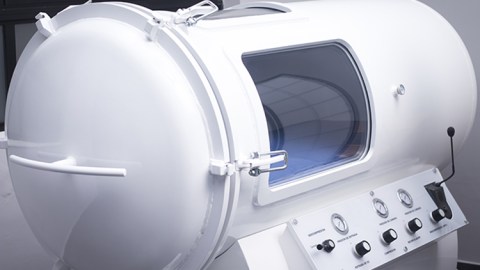The Brain Damage of a Drowned Toddler Was Reversed Through This Surprising Therapy

Back in February of this year, precocious two-year-old Eden Carlson managed to sneak past a series of gates and doors and made it into her own backyard, all while her mother was showering, completely unawares. Then things took a drastic turn. Somehow the little girl slipped and fell into the swimming pool, where she remained submerged for 15 minutes. Her mother and later a responding CMS team, gave her CPR, but to no avail. The child wouldn’t have a heartbeat again until two hours later, when she was revived at the Washington Regional Medical Centre in Fayetteville, Arkansas.
It’s a miracle that doctors were able bring her back. The toddler was discharged after 48 days in critical care. But she suffered significant brain damage. An MRI revealed injury to the deep gray matter and cerebral atrophy, which is where gray and white matter are lost. The effects on her behavior were clear and visible. She wasn’t alert or aware anymore. Little Eden could no longer walk, speak, or even move, as she had. The only physical responses she gave was moving her head or squirming.
Dr. Paul Harch was asked to consult on the case. He soon decided to intervene. Harch is the Director of Hyperbaric Medicine at the LSU Health New Orleans School of Medicine. He teamed up with Dr. Edward Fogarty, of the University of North Dakota School of Medicine, for this case. The doctors decided to employ hyperbaric oxygen therapy (HBOT). This is when a patient lies on a table, which is slid into a plastic tube.

Hyperbaric oxygen therapy (HBOT) is used to treat a varying set of conditions. Getty Images.
The patient is sealed inside then ensconced in oxygen-rich air, generally at two to three times the air pressure of a normal room. The pressurized environment helps the patient absorb more oxygen than they otherwise would. Hyperbaric oxygen therapy is commonly known to treat decompression sickness, known as “the bends” among divers.
This is when too much nitrogen enters the bloodstream too quickly. It can also occur to those who travel to outer space or at high altitudes. For astronauts, high altitude pilots, or deep sea divers, the treatment may not take place inside a tube but rather in an entire room.
Other conditions which may be treated through HBOT include: a brain abscess, severe anemia, carbon monoxide poisoning, radiation injuries, and more. In Eden’s case, the doctors employed normobaric oxygen, or oxygen at the pressure found at sea level.
An oxygen rich environment can help activate certain genes which in turn, lower inflammation inside the brain and aid cell survival. The therapy also stimulates growth hormones which in turn, spark regrowth and regeneration.
Dr. Harch began administering hyperbaric oxygen therapy 55 days after the accident occurred. The child underwent each treatment for 45 minutes, twice daily. The idea was to prevent permanent tissue damage from solidifying inside her brain. Over the course of treatment, they saw dramatic changes take place in Eden.
The child stopped squirming, and became ever more alert and aware. She could soon speak a few words again, grip with her left hand, track people with her eyes, and even partially feed herself.

Those who experience high pressure environments often decompress in a hyperbaric chamber. Getty Images.
The next leg of treatment took place in New Orleans. The child underwent another 40 sessions of HBOT. Researchers noted that after each treatment, Eden showed visible signs of improvement. In fact, the child’s mother said she appeared “near normal” after the 10th session. After the 39th, her speech level was above where it was before the incident. Her cognition also registered normal, and her motor function nearly so.
Eden underwent an MRI after 27 days of treatment. The cortical and white matter atrophy had nearly reversed completely. The results of this remarkable case study were published in the journal Medical Gas Research.
According to Dr. Harch, “The startling regrowth of tissue in this case occurred because we were able to intervene early in a growing child, before long-term tissue degeneration.” What’s more, “Such low-risk medical treatment may have a profound effect on recovery of function in similar patients who are neurologically devastated by drowning.”
To see her story for yourself, click here:





